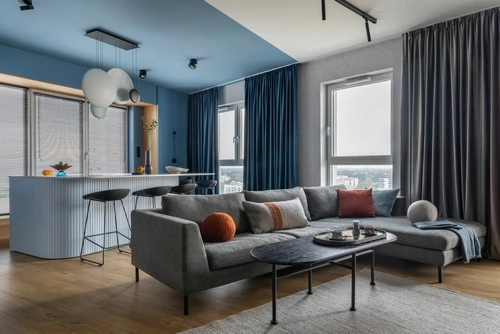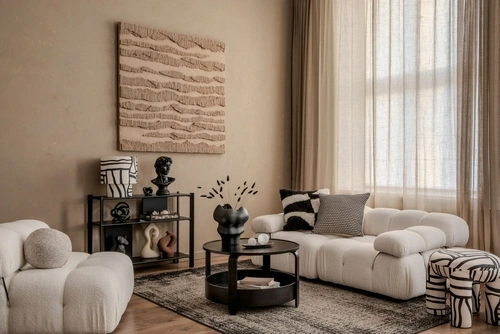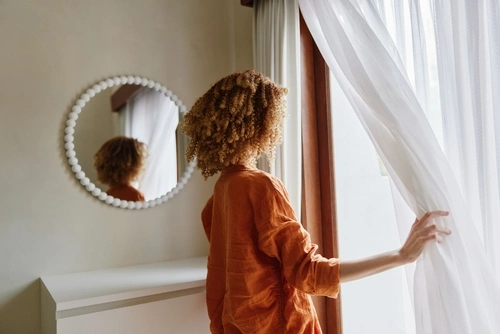The Secret Superpower of Curtains: How This Simple Home Staple Keeps You Warm, Stylish, and Energy-Savvy
The Cozy Truth Behind Your Curtains
Picture this: It’s a frosty evening. The wind is howling outside, you’ve got a cup of tea in hand, and your living room glows softly under lamplight. But there’s something else quietly at work—something that’s saving you money, keeping you warmer, and making your home feel just a little bit more like a hug.
Yes, it’s your curtains.
While most people think of curtains at home as mere decoration—those swaths of fabric chosen to match a sofa or wall color—the truth is, they’re one of the most underappreciated tools for comfort and energy efficiency. They do far more than just frame your windows. When chosen well, hung properly, and used mindfully, curtains at home can literally change how your home feels.
So, do curtains really help keep a house warm? And why are they so important in a room? Let’s pull back the fabric (pun intended) and find out.
How Curtains at Home Actually Work
You might not realize it, but your windows are responsible for a surprising amount of your home’s heat loss. In fact, according to the U.S. Department of Energy, about 30% of a home’s heating energy literally slips out through its windows.

That’s where curtains at home come in—not as a fashion statement, but as a barrier. They work by creating a still layer of air between the cold glass and your cozy living space. This trapped air acts like insulation, slowing down the escape of warmth in winter (and blocking unwanted heat in summer).
“People underestimate how much comfort a good set of curtains can bring,” says interior designer Jane Michaels, who specializes in sustainable home design. “When I help clients redesign older homes, installing well-fitted thermal curtains often makes an immediate difference—not just visually, but physically. The room simply feels warmer.”
How it works, simplified:
-
Thermal barrier: Heavy curtains trap air between fabric and glass, reducing convection (heat flow).
-
Draft protection: Curtains block small air leaks around window edges.
-
Heat reflection: Some fabrics reflect heat into the room instead of letting it escape.
-
Temperature regulation: They help maintain a stable indoor climate day and night.
A Stylish Layer with Serious Benefits
Of course, warmth isn’t the only reason curtains at home matter. They’re an essential design and lifestyle element—touching everything from mood to light control to acoustics.
Here’s why every room benefits when you take your window dressings seriously.
1. They Create Emotional Warmth, Too
A room without curtains often feels unfinished—echoey, exposed, and cold. Add soft drapes, and suddenly the same space feels lived-in, balanced, and comforting.

“Curtains are like the eyelashes of a room,” says home stylist Marcus Lane. “They frame the view, define personality, and soften the harshness of glass and angles.”
The emotional shift is real. Studies on interior psychology show that soft textures and layered materials increase perceived warmth and comfort. Curtains at home, even in light fabrics, create that sensory softness that turns a house into a home.
2. They Control Light and Privacy with Grace
From harsh morning glare to city lights flickering at night, curtains let you decide how much of the world enters your space. In living rooms and bedrooms, that control is essential for relaxation.
Blackout curtains are perfect for bedrooms or media rooms, helping regulate sleep cycles and prevent screen glare.

Sheer curtains filter sunlight beautifully, brightening a space without sacrificing privacy.

Layered curtains (sheer + heavy drape) offer the best of both worlds: daytime glow and nighttime warmth.

And beyond comfort, this balance can protect your home’s interior. Direct sunlight can fade fabrics, artworks, and flooring. By using curtains at home strategically, you reduce UV damage—prolonging the life and beauty of your furnishings.
The Energy-Saving Magic You Can Actually Measure
If all this sounds cozy but a little “too good to be true,” don’t worry—the data agrees.
A study cited by the U.S. Department of Energy found that closing curtains at night can reduce heat loss through windows by up to 10%, while some thermal or lined curtains push that number as high as 25% or more.
Meanwhile, research published in the International Journal of Energy Efficiency suggests that tightly fitted curtains with sealed edges can achieve up to 60% efficiency improvement in single-glazed windows.
That’s not small change. Over a cold winter, this could mean a noticeable drop in heating costs—and a warmer, more stable indoor temperature.
Pro Tip: For maximum efficiency, curtains at home should touch the floor (or windowsill), overlap slightly in the middle, and fit snugly at the top. Avoid gaps—heat loves to sneak through even the smallest spaces!
Design Meets Function: Choosing the Right Curtains at Home
You don’t need to live in a grand manor or start a full renovation to make your curtains work harder. Here’s how to pick the right type for both beauty and performance.
1. Fabric Matters
Different fabrics have different insulating abilities. Think of them like coats for your windows:
| Fabric Type | Warmth Rating | Best Use |
|---|---|---|
| Velvet, wool blends | ★★★★★ | Cold climates, formal rooms |
| Heavy cotton, twill | ★★★★☆ | Living rooms, bedrooms |
| Linen, light polyester | ★★☆☆☆ | Warm climates or layered looks |
| Sheer voile | ★☆☆☆☆ | Light control, not insulation |
If you already have lightweight curtains you love, you can add a thermal lining to boost their performance without changing the look.
2. Layer It Up
A chic trend in home styling right now is double-layered curtains—a sheer layer for daylight and a thick, lined drape for nighttime. It’s both energy-efficient and elegant.
“Layering gives homeowners flexibility,” explains curtain designer Naomi Reed. “In summer, you keep things airy and bright. In winter, you draw the heavier layer and instantly cozy up the room.”
3. Choose Color Wisely
Color affects not only mood but also how heat behaves in your home:
-
Dark, rich tones absorb heat—great for cooler rooms.
-
Light or reflective fabrics repel sunlight—ideal for keeping rooms cool in summer.
A perfect year-round solution? Medium-toned curtains with a white thermal backing, proven to reflect sunlight outward while keeping indoor heat from escaping.
Curtains in Action: Real-Life Transformations
Let’s look at how small curtain changes have made a big difference in real homes.
Case 1: The London Flat That Finally Felt Warm
When interior designer Jane Michaels worked on a chilly Victorian flat in South London, her client’s first request was simple: “Can you make my living room feel less cold without touching the heating system?”
Her solution? Floor-length, fully lined velvet curtains in deep indigo. Within days, the client reported the space was “noticeably warmer,” and their next energy bill showed a small but satisfying drop.
Case 2: The Sun-Baked California Apartment
Across the Atlantic, a young couple in Los Angeles faced the opposite issue—too much sun. By switching from linen curtains to a double layer with a reflective lining, they managed to lower their indoor temperature by around 4°C on hot afternoons, reducing their air-conditioning use.
Case 3: The Heritage Home in Edinburgh
In a centuries-old home with single-glazed windows, the owners added thermal curtains and magnetic edge seals. Result: fewer drafts, a cozier living room, and no need to overuse the electric heater.
Custom Looks, Tailored Light: Discover the TwoPages Difference
Curtains are more than just fabric—they’re the soul of your space. At TwoPages, we craft customizable drapes that match your vision, your vibe, and your windows perfectly. From blackout to linen, modern to classic, we’ve got you covered. Visit twopagescurtains.com today and let your windows make a statement.
Common Curtain Mistakes (and How to Fix Them)
Even beautiful curtains can fail if they’re not used right. Here are the top pitfalls—and how to avoid them:
| Mistake | Why It’s a Problem | Easy Fix |
|---|---|---|
| Curtains too short | Heat escapes through the gap | Choose floor-length or add a thermal liner |
| Gaps at the sides | Drafts sneak in | Use magnetic or Velcro strips to seal edges |
| Drapes over radiators | Traps heat behind fabric | Use shorter curtains or tie-backs |
| Always closed or always open | Misses solar gain | Open during sunny hours, close before dusk |
| Thin fabric, no lining | Poor insulation | Add a separate thermal backing |
Quick Fix: Don’t want to replace your current curtains? You can buy inexpensive thermal curtain liners that clip right onto your existing drapes. They work wonders!
The Designer’s Take: Balancing Beauty and Efficiency
For interior stylists, curtains are one of those rare design elements where aesthetics and functionality truly merge.
“When clients ask where to start transforming a room, I often say: start with the windows,” says Marcus Lane. “Curtains are like the punctuation in a design sentence—they bring clarity and mood. And when they’re insulated or lined? They also bring comfort you can feel.”
That blend of comfort, control, and character is what makes curtains at home such a timeless investment. They don’t just decorate—they elevate.
Seasonal Strategy: Using Curtains All Year Round
-
Winter: Close curtains at dusk to retain heat. Open them in the morning to let in the sunshine.
-
Summer: Keep them drawn during peak sunlight hours to reduce indoor heat gain.
-
Autumn & Spring: Use layered curtains to adapt quickly to shifting temperatures.
This simple daily habit can make your home more energy-efficient—without changing a single appliance.
Editor’s Note: Think of curtains at home as part of your home’s rhythm—open with the day, close with the night. That natural flow mirrors how older homes once managed light and warmth long before modern heating existed.
The Final Layer: Why Curtains Still Matter in the Modern Home
We live in a world of smart thermostats and triple-glazed windows, yet the humble curtain remains a champion of both comfort and style. It’s tactile, timeless, and versatile—and it works quietly behind the scenes.
Curtains at home are not just an accessory. They’re insulation. They’re mood lighting. They’re privacy, texture, and color. They’re an everyday luxury that also makes practical sense.
As Naomi Reed puts it, “A home feels empty without curtains. They’re where warmth meets beauty—and that’s what home is all about.”
Conclusion: Wrap Your Home in Warmth and Style
Next time you draw your curtains, think of it as more than just closing out the world. You’re sealing in comfort, saving energy, and adding beauty to your home in one simple motion. It’s a design choice with heart and logic behind it—a marriage of form and function that truly stands the test of time.
So, whether you’re decorating a cozy flat or a sprawling home, remember this: curtains at home are more than fabric. They’re a statement of how you live, feel, and care for your space. Choose them well, use them wisely, and they’ll give back warmth, peace, and charm for years to come.



